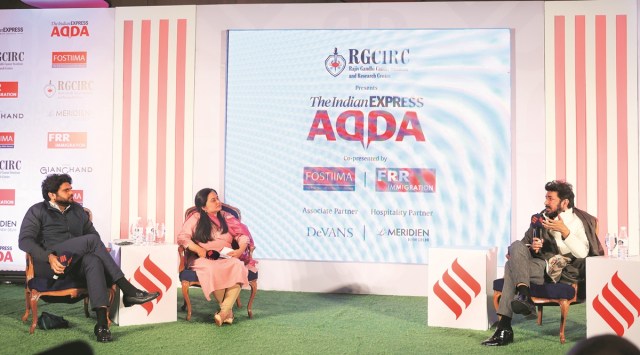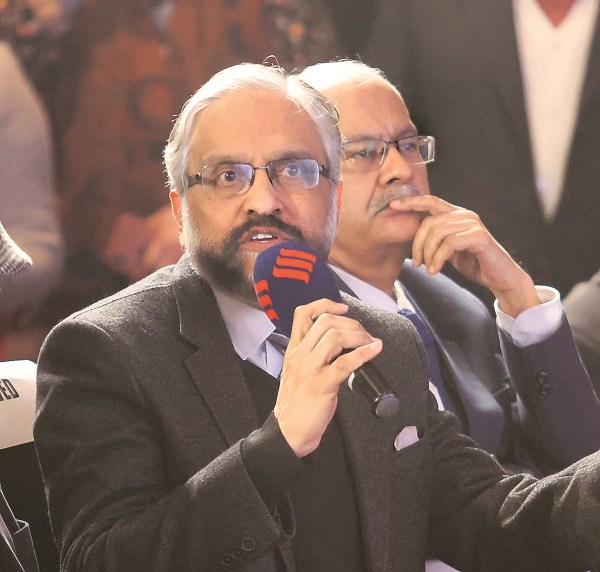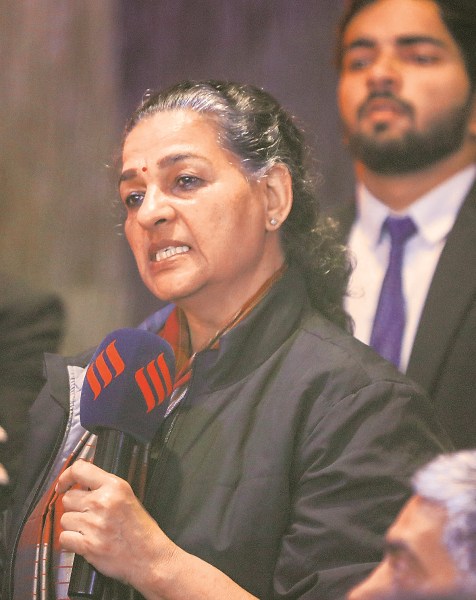Anti-science movement is political but medicine also hasn’t conveyed its value to humans: Dr Siddhartha Mukherjee at Express Adda
At a recent Adda in Delhi, oncologist, researcher and author Siddhartha Mukherjee spoke on his new book, The Song of the Cell (Penguin Allen Lane), on what he means by the new human, Big Pharma, and the anxiety over artificial intelligence
 (From right to left) Oncologist and author Dr Siddhartha Mukherjee in conversation with Devyani Onial, National Features Editor, The Indian Express and Anant Goenka, Executive Director, The Express Group
(From right to left) Oncologist and author Dr Siddhartha Mukherjee in conversation with Devyani Onial, National Features Editor, The Indian Express and Anant Goenka, Executive Director, The Express Group On why there are no rock star scientists any more
The simple answer is that these days, rock stars are rock stars and no one else can displace them. So we are left clutching our test tubes. But that said, obviously the status of science has, in some ways, fallen in the eyes of people. Science itself has dug itself into a hole. Its language has become inaccessible and complicated in a way it wasn’t before. There was a very provocative article in Nature magazine that tried to distinguish between two kinds of ideas in science, one, which they call consolidative, and another, which they call disruptive. Consolidated ideas take vast bodies of knowledge and condense them into something. Disruptive science is quite the opposite. It starts off afield anew. You can apply this metric to economics, social sciences, philosophy, architecture, and art, among others. But the nice thing about science is that you can actually quantify it. Their hypothesis is that if science is truly disruptive, then the first mention of that discovery — let’s take Einstein’s general theory of relativity — is preceded by nothing. It arises sui generis. Darwin’s theory of evolution arises sui generis. In contrast, consolidative science arises out of the consolidation of prior work. The interesting finding is that over time, contrary to our expectations, the number of truly disruptive papers across all the sciences, including some of the social, quantitative social sciences and economics, has actually been decreasing rather than increasing. Why? They advance a number of hypotheses. The hypothesis that I think is most interesting and most believable, is that science is architecturally organised, in a trunk-and-stem manner. In other words, it looks like a tree, rather than what we would call a fireworks manner, which has a centre and lots of things point out of it. Trunk-and-branch architecture has a central stem, and lots of branches come out of it. Science has a trunk-and-stem kind of quality about it, which is that truly disruptive science arises in a trunk-like quality and then moves into multiple branches. The idea is that those trunks are quite rare and in fact, are decreasing.
 Siddharth Mukherjee (right) with Anant Goenka, Executive Director,
Siddharth Mukherjee (right) with Anant Goenka, Executive Director,The Express Group
On anxiety over artificial intelligence
I’m not an expert in artificial intelligence but I engage with it quite a lot. I think there are two general phenomena here. One is the so-called AI and the other is called general AI. There’s not a lot of anxiety about artificial intelligence, per se. It’s the general AI that causes a lot of anxiety. Although, I personally think that both should cause anxieties. For instance, the use of AI in surveillance of citizens is obviously a cause of anxiety. Surveillance of political dissidents is a cause of anxiety. The use of AI in warfare, particularly the combination of robotics and AI in warfare, is a cause of anxiety for me and, legitimately, for the general public. There are other aspects of AI, which I think are not only benign, but very useful. For instance, the use of AI in deciphering patterns in medicine — who’s going to get sick. In predicting genetics, understanding biology and cell biology, etc, which cause much less anxiety.
 Siddhartha Mukherjee’s mother, Chandana Mukherjee
Siddhartha Mukherjee’s mother, Chandana Mukherjee
On what he means by the ‘new human’
In many ways, the creation of new organs and organoids, the interface between cells and devices, including potential devices that go into your brain, in the creation of transplants — transplanted cells, transplanted organs — we are creating humans that we haven’t encountered before. We are creating people who, in some old technologies, would be called cyborgs, although they’re not really cyborgs. They are cell-borgs. They are interfaces between cellular therapies and human beings, and, in being so, really sit at the borderlands of the limits of our current technology. In fact, there may be humans walking among us here, who may have had a bone marrow transplant, and are living chimeras. So their bodies are their own bodies, but their blood is being made from someone else’s body. There will be, very soon, people carrying artificial pancreas. To give you one example that you might think is very prosaic: when the first child was born in a petri dish, Louise Brown, born through IVF, there was no such human being in the world born in and conceived in a petri dish. I think we are creating these new humans. They’re much more real. They are among us. They’re much more real than the science fictional new humans. I think they raise many questions and anxieties about who we are, what we do and what our future looks like.
 Dr Siddhartha Mukherjee with the guests at Express Adda
Dr Siddhartha Mukherjee with the guests at Express Adda
On the anti-science movement
To some extent, medicine has driven itself to the ground and has not fully been able to convey its power and its tremendous impact on human history. Less than a 100 years ago, the chances of dying in childbirth in certain areas was in the order of 20-30 per cent. Childbirth was a deadly event. The chances that you would die before you were 60 years old, were 70-80 per cent. Lifespans were 40, 50 or 60 years. In the last 50-odd years, we’ve seen an extension of lifespan, well into the 80s in some countries. We’ve seen the oldest humans well into the hundreds to 120s and so forth. There’s been a massive change, mostly effected by changes in hygiene, sanitation, social and behavioural health. But, health nonetheless. Medicine has come to represent not those, what I would call profoundly beneficial changes. I think there’s been a lot of politics at work in the anti-science movement, the anti-vaxxer movement being one. Some of it is the fault of medicine itself, in being unable to convey its value to humans, and some of it has been the politicisation and divisiveness and the use of medicine as a scapegoat for political divisiveness, both in this country and in many countries around the world.
On whether Big Pharma is a villain
I think Big Pharma has become the villain, I personally don’t think it is the villain. We would not have the global outreach of vaccination, not just for COVID, but for all vaccines, had it not been for companies, just to name a few — Pfizer, Moderna and AstraZeneca among them. A small start-up cannot produce medicines for the world. You need the pharmaceutical companies. If I was to wave a magic wand and make the pharmaceutical industry disappear, I can guarantee it will be a loss for human beings.
On the other hand, I think the flip side of it is that the pharmaceutical industry needs to take itself and its responsibilities pretty seriously and find a middle ground, which it really hasn’t. I’ll give you one last example of this. All of you must remember the role that Cipla played during the AIDS pandemic at one point of time. In most of Africa, virtually all the AIDS medicines were coming from Cipla until world trade agreements, led by the pharmaceutical lobby, hand-slapped and handcuffed it and essentially monopolised the creation of antiretrovirals. Since then, I think many of these companies have come to realise that there are greater social goods that they need to deliver on and have started taking their role in all of this much more seriously, effectively,
and responsibly.
On cancer therapy and his work in India
Work done in our lab and others has found its way to the creation of T-cell therapy. T-cell therapies are when you extract T cells from a patient and you genetically engineer them in a hyper sterile environment which we’ve created in Bangalore and you make them into anti-cancer fighting machines. You grow them up to a large number and then re-infuse them back into patients. We’ve used them to cure patients, some with deadly diseases like relapsed refractory leukemia. Their mortality without this therapy would be 100 per cent.
On how the pandemic took scientists by surprise
I think that there was a moment of time in which we, as a scientific community, and as a bio-medical community, thought that we understood vaccination, virology and immunology very well. Then, all of a sudden, here comes a virus that really challenges the fundamental things that we know and don’t know about how the immune system works. One example is the phenomenon of long COVID. It raises the question that maybe there are long virus syndromes for many other viruses as well and maybe we just have been ignoring them, because we haven’t been looking for them. So, all of a sudden, our assumptions about what the human body is, how the human body deals with viral infections in the long run have all been quite severely challenged.
On why some people get more severe COVID than others
Surprise number one is that it turns out, some people, apparently healthy, men more than women, have a pre-existing auto-immune disease that invisibly affects their capacity to respond to viruses. It’s only when COVID-19 strikes, that previously invisible incapacity to respond to the virus becomes visible. Those are people who actually get very severely affected by COVID. So that’s one explanation. Some people have genetic changes or mutations or variations in genes that have to do with the immune system. Totally invisible. They go about their lives normally, until COVID hits and all of a sudden, they become susceptible to severe COVID.
Another surprise — major previous active Epstein Barr Virus infections have a strong correlation with long COVID. Why? No one knows. But again, we’re lifting up the mat and beginning to see things.
 Rakesh Chopra, Chairman, Rajiv Gandhi Cancer Institute and Research Centre (RGCIRC) (right) with Dr Sudhir Rawal, Medical Director and Chief of Uro-Gynae Surgical Oncology (RGCIRC)
Rakesh Chopra, Chairman, Rajiv Gandhi Cancer Institute and Research Centre (RGCIRC) (right) with Dr Sudhir Rawal, Medical Director and Chief of Uro-Gynae Surgical Oncology (RGCIRC)
On the emotional toll the profession takes on doctors
There’s burnout, depression, grief among others. Most of us have, over time, evolved mechanisms to deal with it. That doesn’t mean that everyone deals with it successfully. I think situational grief is situational. It’s no hidden secret that there is an enormous degree of psychological and psychiatric toll among physicians.
On the conversation on mental health in India
Classically, there was a lot of underdiagnosis, a lot of stigma. In fact, when we were growing up, there weren’t even words in our lexicon to describe some of the most common mental health aberrations. Now, there are the words, the lexicon is growing. We understand the behavioural and psychosocial elements in a much deeper way. I think the conversation is much more open about it, but I still think most people would agree that there’s a lot of underdiagnoses.
Dr Ambrish Mithal, Chairman and Head of Endocrinology and Diabetes, Max Healthcare

There’s a change in the way diabetes has become more Western in its profile. It’s the same with cancer. Is it lifestyle, pollution or longer lifespan?
I think it’s multifactorial. The extension of lifespan certainly has something to do with it. But it’s not the only thing. So, it’s not the change in the number of cancers, it’s a change in the pie chart of the kinds of cancers and the age at which the cancers are presenting. There’s a changing epidemiology in India. Lung cancer was virtually unheard of 60-70 years ago. In women, it was absolutely unheard of. So the biggest driver clearly is the increase in lifespan. But broader changes are also clearly evident.
Dr Sudhir Rawal, Medical Director and Chief of Uro-Gynae Surgical Oncology, Rajiv gandhi cancer institute and research centre

In the late ’90s and early 2000s, there was a lot of talk about organ cloning and gene therapy. The latter, one thought, could probably cure cancer. Now we do not hear anything.
The T-cell therapies are gene therapies. There are no ifs, ands, or buts about that, and they are curative. As for cloning, the scientific community has worked on making animal models, including pigs, which can be xeno-transplanted into humans. It is going well since the development of new tools and will probably be in patients within the next year or so. So we are there.
Samara Mahindra, Founder and CEO, Carer

What is your take on nutrition and other non-clinical therapies for oncology?
My own intersection with nutrition is much less integrated. Our intersection is very reductive and non-holistic. I am not an expert in nutrition but all I can tell you is that there is a well-established link between obesity and cancer. And we absolutely know that an integrative approach to curbing obesity, which combines both medical and non-medical approaches, is helpful.
Dr Sunil Kala, Founder Trustee, fostiima business school

One has been reading a lot about plant-based food, intermittent fasting and autophagy as prevention and cure for cancer. Are they effective?
You can become quite obese eating plant-based foods. But intermittent fasting is a different story. If you’re going to hold the standard that drugs that work in animals don’t tend to work in humans, you should also hold the standard that intermittent fasting that tends to work in animals may or may not work in humans.
Dr Anoop Misra, Chairman, Fortis C-DOC Hospital for Diabetes and Allied Sciences
 Indian Express ADDA with Siddharth Mukherjee, at Le Meridian, New Delhi, on Monday, January 17, 2023. Express photo by Abhinav Saha
Indian Express ADDA with Siddharth Mukherjee, at Le Meridian, New Delhi, on Monday, January 17, 2023. Express photo by Abhinav Saha
Arsenic trioxide is an established treatment for acute promyelocytic leukemia (APL). People don’t give credence to indigenous systems and any patients of AML (Acute myeloid leukemia) come to Ayurvedic medicine first and then to us. Your thoughts?
APL, for which arsenic trioxide works, is a tiny fraction of all leukemias. In fact, it has absolutely no effect, is poisonous to the human body and to other cancers, if given at the wrong dose… That’s not to deny that there are lots of potential discoveries to be made. The standards neeed to be the same. As long as we do that, we can explore different medicines and interventions.
Sunita Kohli, Interior designer and architectural restorer

The immunotherapy that you are developing in Bengaluru, is that going to be substantially different in pricing to what is presently available in India today?
There isn’t anything in India today, so there’s no comparison. The therapies will be substantially cheaper than they are in the US and in Europe. That said, there’s a fundamental cost of goods associated with making these. So you can only drive the price down to a certain point; before it becomes impossible to produce. We are using every inch of Indian ingenuity to try and bring the cost of goods down to bare bones and survive still as a start-up.
POONAM DABAS, Journalist

Could you comment on COVID and if it was bio warfare.
The idea that it was a pure act of biowarfare seems to be unlikely. There’s a vigorous debate going on that this was an accidental lab leak. Warfare is a different story. I don’t know whether it remains politically feasible to re-explore the question. There are two things that one gains from this debate. If there was even a suspicion of a lab leak, it means we need better systems of lab protection. Secondly, there’s been a lot of political pressure on China to be more transparent in research.
Leher Sethi, Secretary, Indian Council for Human Relations & Indian Council for UN Relations

Is there a connection between living amid pollution and cancer ?
It’s been explored. But not at the depth that we need to. There isn’t a good longitudinal database of cancer in many of the most polluted areas of the world. We need incidence, mortality data, etc. Now, some of this data exists for asthma, for instance. There is good data for growth retardation and stunting in the context of sanitation and pollution. There isn’t very good data on cancer. So it’s an unfortunate gap. I wouldn’t be surprised if there was a link.







